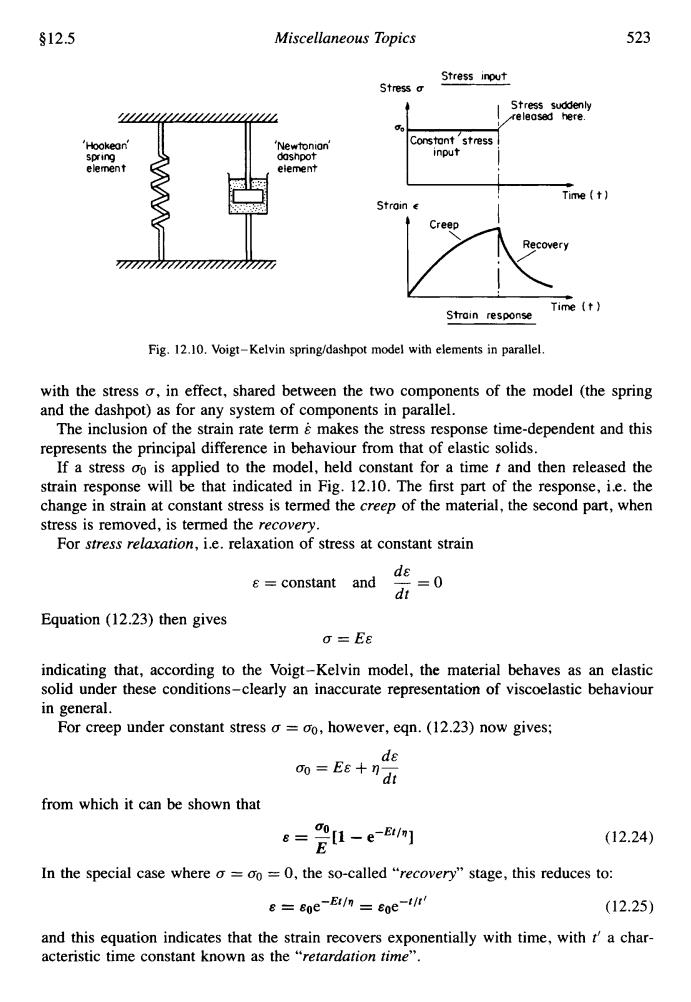正在加载图片...

§12.5 Miscellaneous Topics 523 Stress input Stress o Stress suddenly releosed here. Hookean Newtonion Constont stress spring dashpot input element element Time【t】 Stroin e Creep Recovery 7nnn777n7nn7 Time(t)】 Strain response Fig.12.10.Voigt-Kelvin spring/dashpot model with elements in parallel. with the stress o,in effect,shared between the two components of the model (the spring and the dashpot)as for any system of components in parallel. The inclusion of the strain rate term makes the stress response time-dependent and this represents the principal difference in behaviour from that of elastic solids. If a stress oo is applied to the model,held constant for a time t and then released the strain response will be that indicated in Fig.12.10.The first part of the response,i.e.the change in strain at constant stress is termed the creep of the material,the second part,when stress is removed,is termed the recovery. For stress relaxation,i.e.relaxation of stress at constant strain de 8=constant and dt =0 Equation (12.23)then gives o=E8 indicating that,according to the Voigt-Kelvin model,the material behaves as an elastic solid under these conditions-clearly an inaccurate representation of viscoelastic behaviour in general. For creep under constant stress o =oo,however,eqn.(12.23)now gives; de oo=Ee+n from which it can be shown that cm (12.24) In the special case where o =oo =0,the so-called "recovery"stage,this reduces to: e=soe-Ei/n soe-1/ (12.25) and this equation indicates that the strain recovers exponentially with time,with t'a char- acteristic time constant known as the "retardation time".$12.5 Miscellaneous Topics 523 Stress input Stress u ’Hookeon’ ‘Newtonian’ doShpot element Stress suddenly eleased here. Strain E I Tine(t) I Creep r; Time Strain response (t) Fig. 12.10. Voigt-Kelvin spring/dashpot model with elements in parallel. with the stress 0, in effect, shared between the two components of the model (the spring and the dashpot) as for any system of components in parallel. The inclusion of the strain rate term & makes the stress response time-dependent and this represents the principal difference in behaviour from that of elastic solids. If a stress 00 is applied to the model, held constant for a time t and then released the strain response will be that indicated in Fig. 12.10. The first part of the response, i.e. the change in strain at constant stress is termed the creep of the material, the second part, when stress is removed, is termed the recovery. For stress relaxation, i.e. relaxation of stress at constant strain ds dt E =constant and - =O Equation (1 2.23) then gives 0 = EE indicating that, according to the Voigt-Kelvin model, the material behaves as an elastic solid under these conditions -clearly an inaccurate representation of viscoelastic behaviour in general. For creep under constant stress = ao, however, eqn. (12.23) now gives; from which it can be shown that (1 2.24) In the special case where a = 00 = 0, the so-called “recovery” stage, this reduces to: E = Eoe-Ef/s = Eoe-f/f‘ (1 2.25) and this equation indicates that the strain recovers exponentially with time, with t’ a characteristic time constant known as the “retardation time